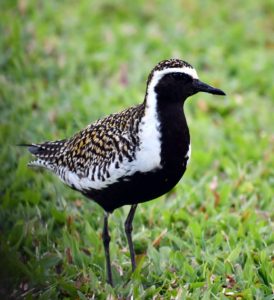
Our Jake, Kailua, April 13, 2021. Disappeared April 18th, likely gone to join a flock for liftoff. ©Susan Scott
April 23, 2021
It’s time to get our hankies out to wave goodbye to our beautiful, personable, and amazing Pacific Golden Plovers. We worry about their welfare during their perilous journeys, and we miss our Kolea when they’ve gone, but we won’t be plover-less for long. A few birds will stick around this summer, and migrating parents will be back in August and September, followed by their chicks’ arrival in October and November.
How the summer-hatched offspring know where to go, and when, is a marvel of nature. Yet a chick’s arrival in Hawaii is only its first hurdle. The youngster must then find an empty and productive foraging space. Most don’t survive their first year, but the ones that do can live 20 years or more.
We ended this year’s first-ever statewide Kolea Count trial on March 31st because in April, the birds start moving from their established winter foraging territories. Kolea migrate in flocks, and congregate before liftoff. Plovers that vigorously defended their space from one another all winter are, in April, all buddy-buddy.
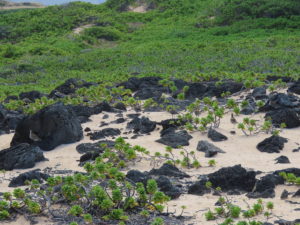
DLNR/DSP Interpretive Technician, Lesley MacPherson, photographed this gathering of 13 Kolea at Kaena Point on Thursday April 22. Only one was in this area all winter. Can’t see 13? Check out the photo below.
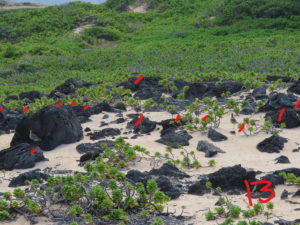
Lesley helpfully pointed out, with red marks, each of the 13 Kolea in the photo above.
The most frequent question I get from plover lovers this month is, “Where can I see the Kolea flocks gathering for take-off?”
Good question. We have a few confirmed spots from the past, such as Kualoa Regional Park, and Ford Island. Now that people have a place to report the gatherings, we’re getting more flock descriptions.
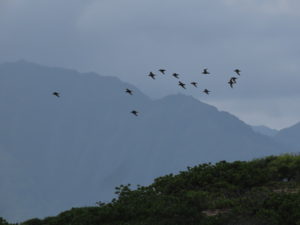
Kolea flock at Kaena Point, April, 22, 2021. Courtesy Lesley MacPherson
This winter, counts on Sandy Beach Park’s grassy field ranged from one to seven birds, depending on kite flying and other human activity. Last week, Kolea counter Michael Feeley reported more than 50 plovers there.
Sigrid Southworth, who completed six thorough counts at Punchbowl Cemetery this winter between December 1 and March 31, (number range 72-100) told me last week that the birds are not in their usual places. During my recent drive-through in the crater with Sig, we saw a couple male and female pairs standing near one another. In winter, such proximity would cause a fight.
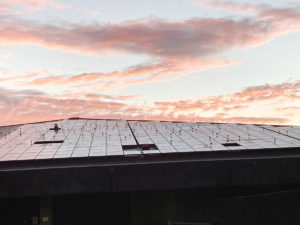
Kolea on a solar-paneled roof top at UH Hilo. Photo courtesy Kanoe McTavish
No one knows if the couples that form here stay together during migration and breeding. This is why placing colored bands on the birds’ legs is so important. It’s the only way to know for sure what the birds are doing mating-wise, where they go, and how long they live.
The December through March head count will continue for the next 10 years. But although this winter’s trial count is over, reporting of observations on koleacount.org go year-round. Most of the birds depart Hawaii the end of April, but some stick around into May. Individuals that haven’t gained the fat they need to make the 3,000-mile nonstop journey, spend the summer here.
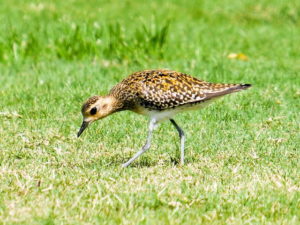
Birds like this Kolea, photographed last June at Kalani High School, don’t usually molt into breeding colors if they aren’t fit to migrate. Photo courtesy Ted Simon
This spring and summer please report: 1) the last date you saw your bird in April or May, 2) any Kolea you see in June, and 3) the first ones you see in July or August. Early returnees have had either a superb breeding season, where chicks matured early and parental duties were over, or a disastrous one where eggs or chicks were lost due to an extreme weather event or predation.
![]() Few wild birds bring so much joy to so many people, especially this year when life changed for so many of us. For me, seeking out the plovers and finding them prancing about as usual eased the pain of the pandemic. Hawaii’s migratory shorebirds are a good reminder that some things in the world are still OK.
Few wild birds bring so much joy to so many people, especially this year when life changed for so many of us. For me, seeking out the plovers and finding them prancing about as usual eased the pain of the pandemic. Hawaii’s migratory shorebirds are a good reminder that some things in the world are still OK.
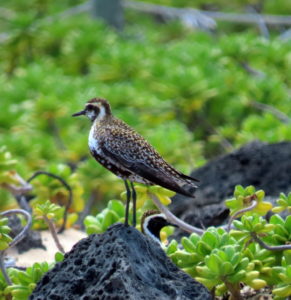
Females in full breeding plumage, such as this one at Kaena Point this week, have mottled breasts, with some white spots. Male breasts (and cheeks, below this female) are solid black. Lesley MacPherson, DLNR/DSP
![]() For my Kolea Count update slide show given via Zoom on April 1st at the Hanauma Bay Education Program, go to: https://www.youtube.com/watch?v=UyMmvnq4cNA
For my Kolea Count update slide show given via Zoom on April 1st at the Hanauma Bay Education Program, go to: https://www.youtube.com/watch?v=UyMmvnq4cNA
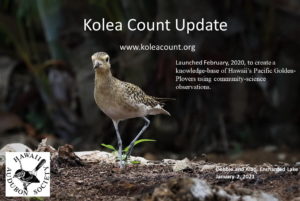
![]()